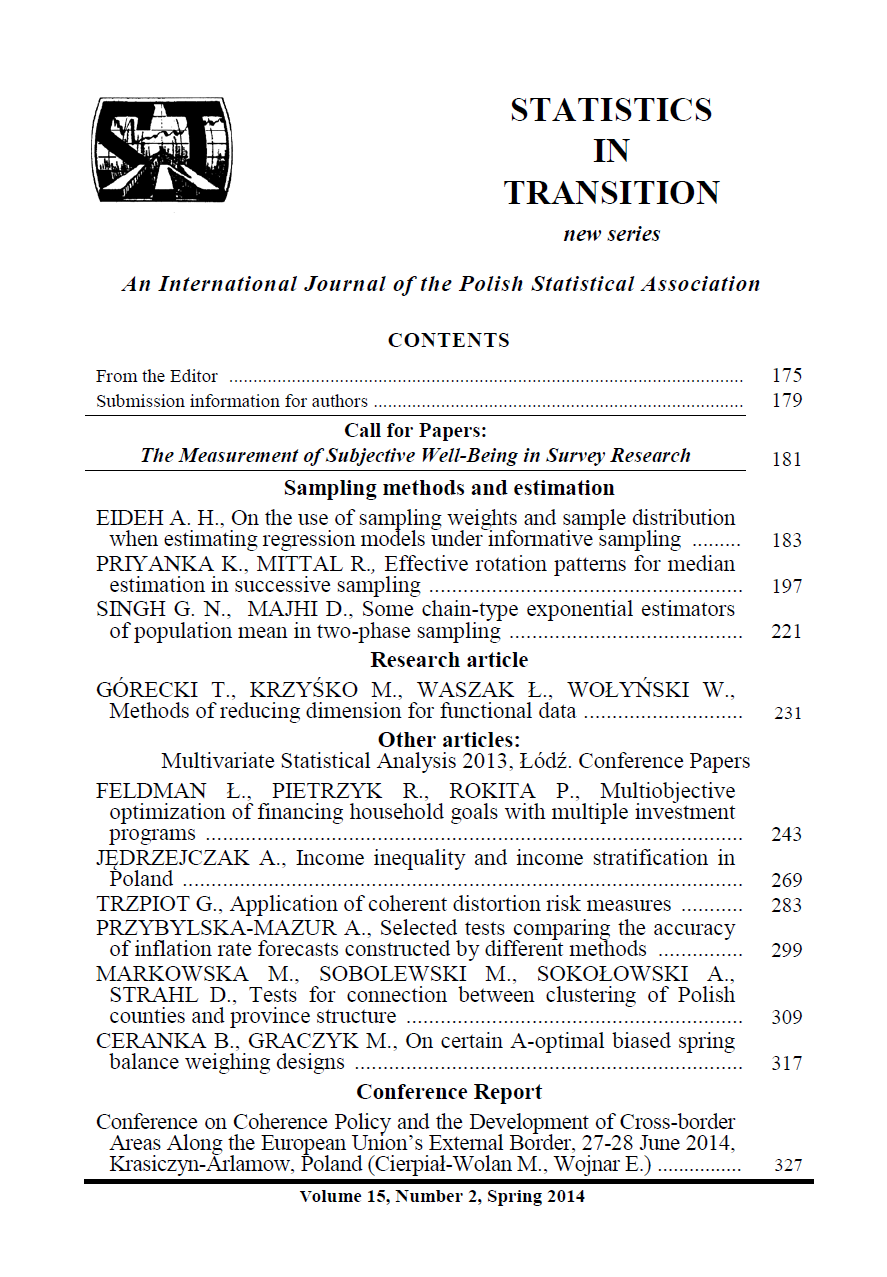ARTICLE
ABSTRACT
This article proposes a technique of facilitating life-long financial planning for a household by finding the optimal match between systematic investment products and multiple financial goals of different realization terms and magnitudes. This is a multi-criteria optimization. One of the objectives is compliance between the expected term structure of cumulated net cash flow throughout the life cycle of the household with its life-length risk aversion and bequest motive. The second is financial liquidity in all periods under expected values of all stochastic factors. The third is minimization of net cash flow volatility. The fourth is minimization of costs of the investment plan combination. The result is a set of systematic-investment programs with accompanying information which programs are destined to cover which financial goal. Payoffs of one program may be used to cover more than one goal and the order may be other than sequential. An original goal function, constructed to suit conditions and assumptions of the proposed household financial plan model, is presented as an optimization procedure
KEYWORDS
multiobjective optimization, personal finance, asset selection, intertemporal choice
REFERENCES
AINSLIE, G., (1991). Derivation of „Rational” Economic Behavior from Hyperbolic Discount Curves. The American Economic Review, 81(2), pp. 334–340.
AINSLIE, G., (1975). Specious reward: A behavioral theory of impulsiveness and impulse control. Psychological Bulletin 82(4), pp. 463–496.
ANDO, A., MODIGLIANI, F., (1957). Tests of the Life Cycle Hypothesis of Saving: Comments and Suggestions. Oxford Institute of Statistics Bulletin, Vol. XIX (May), pp. 99–124.
BODIE, Z., DETEMPLE, J., OTRUBA, S., WALTER, S., (2004). Optimal Consumption-Portfolio Choices and Retirement Planning. Journal of Economic Dynamics and Control, 28, pp. 1115–1148.
BODIE, Z., MERTON, R. C., SAMUELSON, W. F., (1992). Labor Supply Flexibility and Portfolio Choice in a Life Cycle Model. Journal of Economic Dynamics and Control, 16(3-4), pp. 427–249.
BODIE, Z., TREUSSARD, J., WILLEN, P., (2007). The Theory of Life-Cycle Saving and Investing. [online] Federal Reserve Bank of Boston: Research Paper, no. 07-3. Available at:
CARBONE, E., INFANTE, G., (2012). The Effect of a Short Planning Horizon on Intertemporal Consumption Choices. [online] LABSI: Research Paper. Available at:
DUS, I., MAURER, R., MITCHELL, O. S., (2004). Betting on Death and Capital Markets in Retirement: A Shortfall Risk Analysis of Life Annuities versus Phased Withdrawal Plans. [online] Goethe-Universität, Frankfurt am Main and The Wharton School, University of Pennsylvania: Working Paper. Available at:
FELDMAN, L., PIETRZYK, R., ROKITA, P., (2014a). A practical method of determining longevity and premature-death risk aversion in households and some proposals of its application, in: Spiliopoulou, M., Schmidt-Thieme, L., Janning, R. (Eds.), Data Analysis, Machine Learning and Knowledge Discovery, Studies in Classification, Data Analysis, and Knowledge Organization. Springer International Publishing, pp. 255–264.
FELDMAN, L., PIETRZYK, R., ROKITA, P., (2014b). General strategies to meet household pension goal versus longevity risk, in: Lisowski J., Łyskawa K. (Eds.), Insurance in view of longevity/old age risk. Poznań University of Economics Publishing House, pp. 37–49.
GEYER, A., HANKE, M., WEISSENSTEINER, A., (2009). Life-cycle asset allocation and consumption using stochastic linear programming. The Journal of Computational Finance, 12(4), pp. 29–50.
GOMPERTZ, B., (1825). On the Nature of the Function Expressive of the Law of Human Mortality, and on a New Mode of Determining the Value of Life Contingencies. Philosophical Transactions of the Royal Society of London, 115, 513–585.
GONG, G., WEBB, A., (2008). Mortality Heterogeneity and the Distributional Consequences of Mandatory Annuitization. The Journal of Risk and Insurance, 75(4), pp. 1055–1079.
HUANG, H., MILEVSKY, M. A., (2011). Longevity Risk Aversion and Tax Efficient Withdrawals. [online] SSRN. Available at:
HUANG, H., MILEVSKY, M. A., SALISBURY, T. S., (2012). Optimal Retirement Consumption with a Stochastic Force of Mortality. Insurance: Mathematics and Economics, 51(2), pp. 282–291.
KIRBY, K. N., HERRNSTEIN, R. J., (1995). Preference reversals due to myopic discounting of delayed reward. Psychological Science, 6(2), pp.83–89.
MAKEHAM, W. M., (1860). On the Law of Mortality and the Construction of Annuity Tables. Journal of the Institute of Actuaries and Assurance Magazine,8, pp. 301–310.
MERTON, R. C., (1969). Lifetime portfolio selection under uncertainty: The continuous time case. The Review of Economics and Statistics, 51(3), pp. 247–257.
MERTON, R. C., (1971). Optimum consumption and portfolio rules in a continuous-time model. Journal of Economic Theory, 3(4), pp. 373–413.
MILEVSKY, M. A., HUANG, H., (2011). Spending Retirement on Planet Vulcan: The Impact of Longevity Risk Aversion on Optimal Withdrawal Rates. Financial Analysts Journal, 67(2), pp. 45–58.
MODIGLIANI, F., BRUMBERG, R. H., (1954). Utility analysis and the consumption function: an interpretation of cross-section data. In: Kenneth K. Kurihara, ed. 1954. Post-Keynesian Economics. New Brunswick, NJ: Rutgers University Press. pp. 388–436.
NISSENBAUM, M., RAASCH, B. J., RATNER, C., (2004). Ernst & Young’s Personal Financial Planning Guide. John Wiley & Sons, Inc. 237–522.
RICHARD, S. F., (1975). Optimal consumption, portfolio and life insurance rules for an uncertain lived individual in a continuous time model. Journal of Financial Economics, 2, pp. 187–203.
SCHOLZ, K., SESHADRI, A., (2012). Health and Wealth In a Lifecycle Model. [online] University of Wisconsin-Madison and NBER and University of Wisconsin-Madison: Working Paper. Available at http://www.ssc.wisc.edu/~scholz/Research/Health_and_Wealth_v16.pdf [Accessed: 23 Nov. 2013].
SUNDARESAN, S., ZAPATERO, F., (1997). Valuation, optimal asset allocation and retirement incentives of pension plans. Review of Financial Studies, 10, pp. 631–660.
YAARI, M. E., (1965). Uncertain Lifetime, Life Insurance and Theory of the Consumer. The Review of Economic Studies, 32(2), pp.137–150
